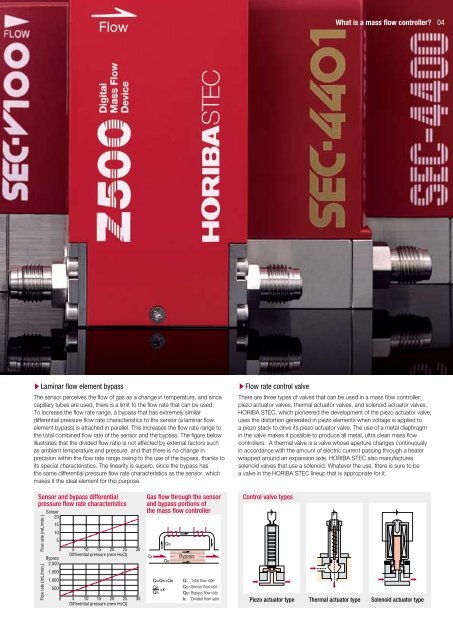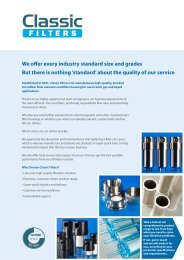SEC-400series - Shavo Technologies
SEC-400series - Shavo Technologies
SEC-400series - Shavo Technologies
Create successful ePaper yourself
Turn your PDF publications into a flip-book with our unique Google optimized e-Paper software.
sLaminar flow element bypass<br />
The sensor perceives the flow of gas as a change in temperature, and since<br />
capillary tubes are used, there is a limit to the flow rate that can be used.<br />
To increase the flow rate range, a bypass that has extremely similar<br />
differential pressure flow rate characteristics to the sensor (a laminar flow<br />
element bypass) is attached in parallel. This increases the flow rate range to<br />
the total combined flow rate of the sensor and the bypass. The figure below<br />
illustrates that the divided flow ratio is not affected by external factors such<br />
as ambient temperature and pressure, and that there is no change in<br />
precision within the flow rate range owing to the use of the bypass, thanks to<br />
its special characteristics. The linearity is superb, since the bypass has<br />
the same differential pressure flow rate characteristics as the sensor, which<br />
makes it the ideal element for this purpose.<br />
Sensor and bypass differential<br />
pressure flow rate characteristics<br />
Flow rate (mL/min.)<br />
Flow rate (mL/min.)<br />
Sensor<br />
20<br />
15<br />
10<br />
5<br />
0 5 10 15 20 25 30<br />
Bypass<br />
2,000<br />
Differential pressure (mm H2O)<br />
1,500<br />
1,000<br />
500<br />
0 5 10 15 20 25 30<br />
Differential pressure (mm H2O)<br />
Gas flow through the sensor<br />
and bypass portions of<br />
the mass flow controller<br />
Q=QS+QB<br />
QB<br />
QS =k<br />
QS<br />
Q Bypass<br />
QB<br />
Q: Total flow rate<br />
QS: Sensor flow rate<br />
QB: Bypass flow rate<br />
k: Divided flow ratio<br />
sFlow rate control valve<br />
There are three types of valves that can be used in a mass flow controller:<br />
piezo actuator valves, thermal actuator valves, and solenoid actuator valves.<br />
HORIBA STEC, which pioneered the development of the piezo actuator valve,<br />
uses the distortion generated in piezo elements when voltage is applied to<br />
a piezo stack to drive its piezo actuator valve. The use of a metal diaphragm<br />
in the valve makes it possible to produce all metal, ultra clean mass flow<br />
controllers. A thermal valve is a valve whose aperture changes continuously<br />
in accordance with the amount of electric current passing through a heater<br />
wrapped around an expansion axle. HORIBA STEC also manufactures<br />
solenoid valves that use a solenoid. Whatever the use, there is sure to be<br />
a valve in the HORIBA STEC lineup that is appropriate for it.<br />
Control valve types<br />
Piezo actuator type<br />
What is a mass flow controller? 04<br />
Thermal actuator type<br />
Solenoid actuator type




